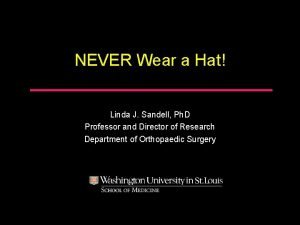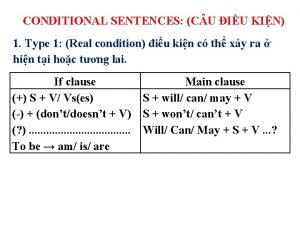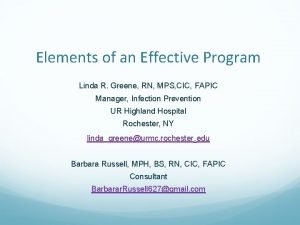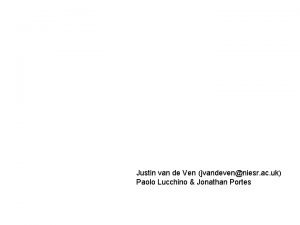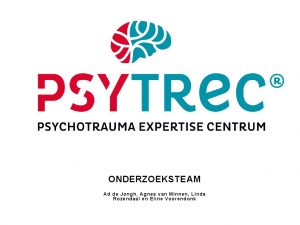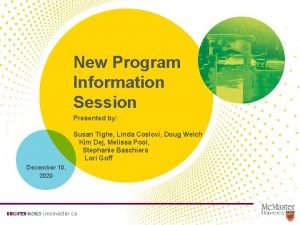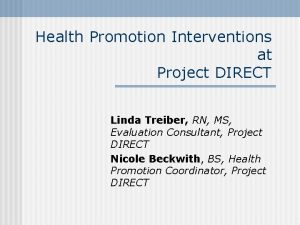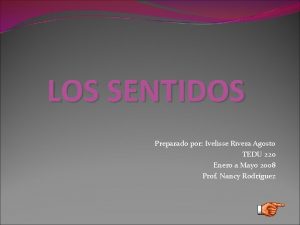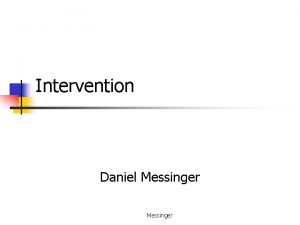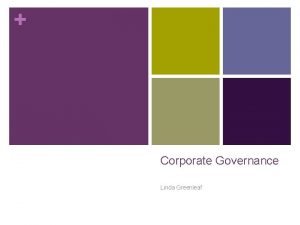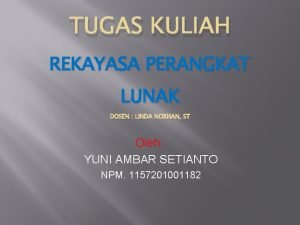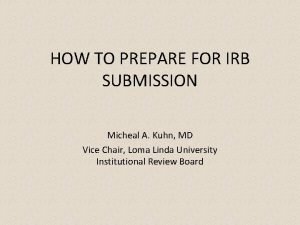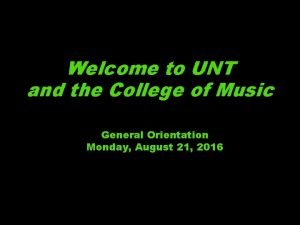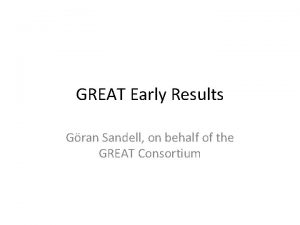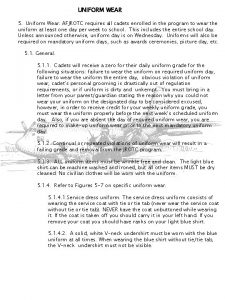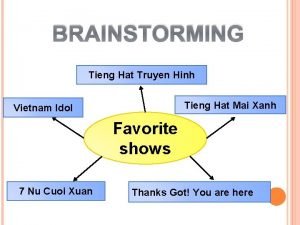NEVER Wear a Hat Linda J Sandell Ph














































- Slides: 46

NEVER Wear a Hat! Linda J. Sandell, Ph. D Professor and Director of Research Department of Orthopaedic Surgery

Giving a Good Scientific Talk v. Talk basics v. Extemporaneous talks v. Multicultural talks

Act like a Lion My topic is extremely important

Material to Include in Your Talk: Tell a Story v Introduction - with motivation and set in context v Methods - approach and caveats v Results – salient details Be careful of equations, pathways v Conclusion/Summary – 3 -4 points MAX

Material to Include in Your Talk: Tell a Story v Future Research – return to context Be reasonable and accurate v This biomarker will be used to monitor progression in early OA, filling a gap in the fied v. This biomarker will aleviate the bottleneck in clinical trials

Tell a Story v. Most important – simple and linear ♦ Not all experts ♦ Even experts don’t want to work that hard!

Timing v 60 minute slot ♦ 40 minute talk (about 30 -40 slides) ♦ 4 minutes late start ♦ 5 minutes introduction ♦ 5 minutes interruptions ♦ 5 minutes questions

Breathe! How to Overcome Anxiety when Speaking in Public

What is the worst thing that could happen when I give my presentation?

The Worst Things That Can Happen v You forget your Power. Point and don’t remember what you were going to say. v You arrive late and the audience members are already seated and are waiting for you. Some of them cough nervously as you walk to the stage. v You trip and fall on stage. v You trip and fall on the way to the stage.

The Worst Things That Can Happen v Your supervisor is in the audience and you are up for promotion. v Just before you begin your talk, you see your most threatening rival who is also your worst critic. v When you are giving your talk, members of the audience are mumbling and giggling.

The Worst Things That Can Happen v You are walking on stage as you give your talk and a sudden embarrassing sound comes from you (and it isn’t your voice). v You stumble and stutter. v You lose your voice. v The audience begins to fall asleep. You are boring!

The Worst Things That Can Happen v You ask if there any questions and no one answers. v You look for validation from the audience and all you see is puzzlement. v Members of the audience roll their eyes when you make what you think is an important point. v Someone challenges you, and you feel yourself begin to cry.

How can I keep this from happening?

Be Prepared

Be Prepared If you know what you are saying and why you are saying it, and you care about what you are saying, you will say it well.

How to be a Good Public Speaker v. Be Prepared v. Be Committed v. Be Interesting v. Relax

Be Prepared v Select Your Topic and Purpose v Analyze Your Audience v Research Your Topic v Develop Your Thesis and Main Points v Organize Your Speech Materials

Be Prepared v Support Your Main Points v Construct Your Introduction, Conclusion, and Transitions v Rehearse Your Speech and Rehearse it Again (and Again) v Time Your Speech - Analyze Your Audience v Research Your Topic v Develop Your Thesis and Main Points

Be Prepared v. Arrive at least 30 minutes early and if possible, check out the venue the day before. v. Bring your PPT with you. v. Bring your own mouse.

Be Prepared v Create an outline using Microsoft Word: ♦ Use large font for readability, and ♦ Put your outline and/or notes on a large note card or folded sheet of paper. v When you arrive, check to make sure that the technology works (PPT, Internet access). Also make sure that you have the telephone number of the IT personnel who can help you.

Be Prepared v Chat with the audience as they arrive. v Check room layout: ♦ Clock? Bring your own watch. ♦ Seating? ♦ Microphone? Laser pointer? ♦ Who is in the audience? Can you refer to them by name?

Be Prepared v Perform deep-breathing exercises beforehand to help you relax. v Wear comfortable clothing. v Step away from the podium. v Move with purpose, usually at transition points. v Use hand gestures to channel adrenalin. v Limit use of the laser pointer.

Be Prepared v Speak loud enough for the entire audience to hear, and check with them at the beginning to make sure that they can. v Don’t apologize for yourself (e. g. , Sorry that I’m late…Sorry, but I just threw this together…. Sorry if you can’t read the slides). v Monitor and stop verbal ticks (e. g. , umm, uh) and distracting movements (e. g. , toe tapping). v Your message is important, so work at being a professional so people take you seriously.

Be Prepared v Be prepared for difficult questions: ♦ Pause with a drink of water. ♦ “I am glad that you asked that question, however I am not prepared to answer it right now. See me after the session…. ” ♦ “I appreciate your point, but we need to move on…. . ” ♦ Redirect the question: “I am interested in hearing what you think about that topic” or “Let’s ask other members of the audience what they think. ”

Be Interesting

Be Interesting v In other words, don’t be boring. v Engage your audience: ♦ Listen to them (one-on-one, in small groups, or even in large groups). ♦ Interact with them by asking questions and validating their answers ( “Yes, I understand what you are saying. . . ”).

Be Committed

Be Committed v Understand that you will need to give at least one talk in your career, so commit to being the best public speaker that you can be. v Understand that you will be questioned and challenged, but ♦ Don’t take it personally, ♦ It could be an opportunity for you to do better next time.

Relax


Relax v Take your job seriously, but don’t take yourself too seriously. In other words, relax. v If you make a mistake, forgive yourself. No one is perfect. v Use humor, but only if appropriate and only if you can truly pull it off.

If you are shy, emulate others.

Who is your role model for public speaking? Why?

A Few Tips About Power. Point® v Keep It Simple ♦ Use only a few graphic elements and please do not over-animate. ♦ Use only a few points (phrases, sentences) on each slide. ♦ Do not read the slides unless you are critically nervous. ♦ Give copies of the presentation in handout form after the presentation so that your audience remains engaged.

Remember that if you fail, you can do it again, and each time it gets better and better.

1 -minute Presentation v. Your name v. Your institution v. Tell us something interesting about you (hobbies, pets, family, sports, exercise, books you like to read, what you did on vacation this summer, why you like/don’t like to give presentations).

Speaking to a Multi-Cultural Audience v The GOAL is to communicate. v Use every thing you can!

Speaking to a Multi-Cultural Audience v Start with enthusiasm and indicate respect for your audience v Speak S L O W L Y and distinctly, using non-verbal communication to amplify your words ( varied facial expressions, voice modulation and hand gestures) v Be clearly seen

Speaking to a Multi-Cultual Audience v Don’t say anything critical for the first few minutes – it takes time to adjust to a language, accent and style. v ALWAYS use the simpler word when there is a choice. “Drug” is better than “pharmaceutical agent”. “Most” is better than “preponderance” v Avoid words that are hard for you to pronounce. v Repeat major points in slightly different ways – but make sure that the audience understands you are doing it.

Speaking to a Multi-Cultural Audience v Mix material that is familiar with material that is new (1: 1) v Maintain eye contact, scanning the room to stay in touch v Use simple and clear visual aids. No letters smaller than 20 pt. v Use Arial (sans serif) rather than Times Roman (serif)

v Summarize frequently, in words and slides v Welcome questions during and after. Repeat the question. Address the entire audience v Seek feedback. Self assess immediately after the talk and make notes.

Mannerisms – avoid irritating people v Dress well – be professional Let the data be impressive v Avoid “ahhhh” “Ummmm” v Don’t figit – flamingo v Never, ever get irritated v Don’t be arrogant – even if you win a Nobel Prize

v Say Thank you v. NEVER wear a hat!

Have Fun v If you don’t enjoy it – don’t do it. v But I think you love it …

Acknowledgements v Roger Ailes: “You Are The Message: Getting What You Want by Being Who You Are” v Joseph De. Vito: “The Essential Elements of Public Speaking” v W. Edwin Dodson, M. D. , Associate Vice Chancellor and Associate Dean for Admissions and Continuing Medical Education, Professor of Pediatrics and Neurology, Washington University School of Medicine v Swarthmore College Gratuitous advice on giving a talk ♦ www. swarthmore. edu/Nat. Sci/cpurrin 1/powerpointadvice. htm ♦ Good advice on powerpoint and other topics
 Red hat white hat black hat
Red hat white hat black hat He never wear a hat
He never wear a hat Then wear the gold hat if that will move her
Then wear the gold hat if that will move her Pengertian teater mancanegara
Pengertian teater mancanegara Blue hat stands for
Blue hat stands for I never wear socks
I never wear socks La 1301
La 1301 The same god who never fails
The same god who never fails We are never never weary
We are never never weary What runs but never walks
What runs but never walks He never polishes his shoes so he never looks smart
He never polishes his shoes so he never looks smart He never polishes his shoes, so he never looks smart
He never polishes his shoes, so he never looks smart Your love never fails never gives up on me
Your love never fails never gives up on me Linda coordination language
Linda coordination language Linda r greene
Linda r greene Linda-model.net
Linda-model.net Linda mynarik
Linda mynarik Second conditional structure
Second conditional structure Linda bradford raschke trading sardines pdf
Linda bradford raschke trading sardines pdf Emdr knaller
Emdr knaller Meu coração alegre hoje canta
Meu coração alegre hoje canta Linda grave
Linda grave Parrafo conceptual
Parrafo conceptual Uma linda mensagem para hoje
Uma linda mensagem para hoje Linda anne luzzicone
Linda anne luzzicone Linda hendriks
Linda hendriks Susan tighe mcmaster
Susan tighe mcmaster Linda sustantivo
Linda sustantivo Correspondence bias
Correspondence bias What kind of triangle is this
What kind of triangle is this Linda treiber
Linda treiber Linda gottfredson
Linda gottfredson Linda skylar
Linda skylar Sentido del oído para niños
Sentido del oído para niños Linda hemsworth
Linda hemsworth Emma linda
Emma linda Jacaap
Jacaap Linda greenleaf
Linda greenleaf Linda schoots - verkleij
Linda schoots - verkleij Linda sue park a long walk to water
Linda sue park a long walk to water Linda norhan
Linda norhan Linda grubišić belina
Linda grubišić belina Loma linda earthquake 1989
Loma linda earthquake 1989 Linda woudstra
Linda woudstra Una tarde cargada de experiencia
Una tarde cargada de experiencia Loma linda irb
Loma linda irb Unt schedule builder
Unt schedule builder

